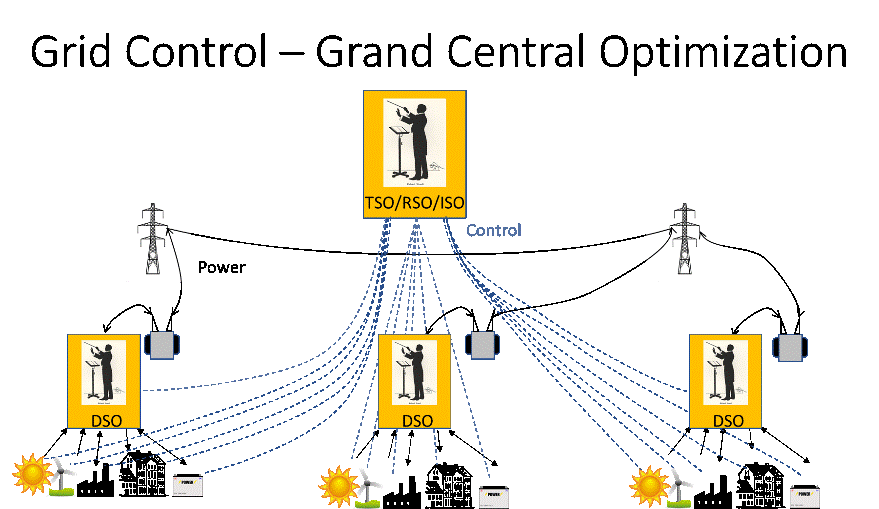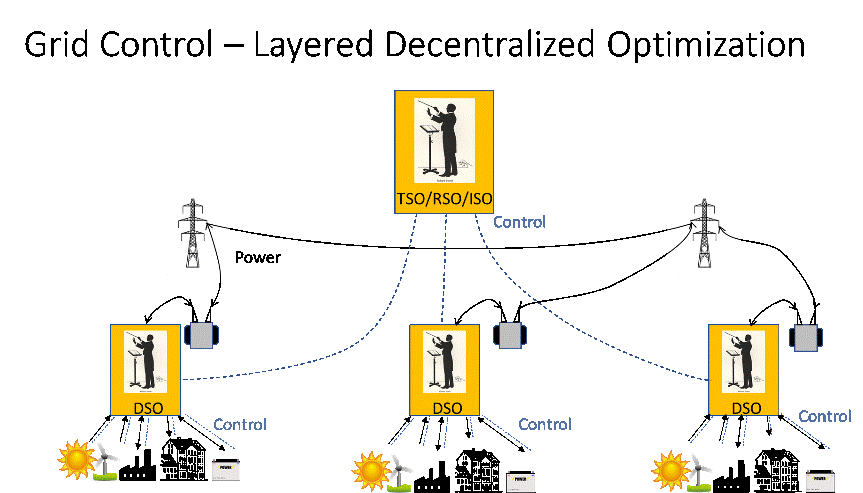

So how can a decentralized electric system with high penetration of distributed energy resources (DERs) operate to provide reliable electric power at the lowest cost? Originally proposed by the U.S. Department of Energy’s Gridwise Architecture Council in 2015, a Transactive Energy Framework could be the answer. Consider that we started with an electric grid that was a vertically integrated with central generation that fed power one way to all customers and was managed by the central utility. Even with deregulation separating generation and distribution functions, there is still a need to balance generation and load in some manner. Here, a transactive energy (TE) market or TE, could provide “a system of economic and control mechanisms that allows the dynamic balance of supply and demand across the entire electrical infrastructure using value as a key operational parameter.” The value of electric energy varies by location and time. With distributed generation, thousands of generators with many solar and wind systems make such a system highly complex. Some argue that it is the most important and complex systems integration issue of our time.
A major advance in electricity pricing theory occurred in 1988 when four professors at MIT and Boston University (Fred C. Schweppe, Michael C. Caramanis, Richard D. Tabors, and Roger E. Bohn) published a book entitled, "Spot Pricing of Electricity." It presented the concept that prices at each location on a transmission system should reflect the marginal cost of serving one additional unit of demand at that location. It then proposed a control system solution to determine these prices by solving a systemwide cost-minimization problem while complying with all the system's operational constraints (generator capacity limits, locational loads, line current limits, and so on). Linear programming (LP) optimization algorithms are used to solve the problem. The locational marginal prices (LMP), then emerged as the LP solution by computing the shadow prices for relaxing the load limit at each location.
These grid control ideas led to the U.S. Energy Policy Act of 1992. Later, in 1996, FERC issued the landmark order 888 which was intended to deregulate the vertical electric power market and separate generation from transmission. Various market-based reforms are still on-going. Some implementations have had partial success, but the TE market is far from a solved problem with plenty of technical implementation problems and no shortage of political influences. For example, consider a homeowner with a solar PV system and battery storage, and flexible load schedules for an electric water heater, flexible HVAC setpoints for summer peak loads, and flexible EV charging. Such a homeowner has zero capability to opt into any type of wholesale markets or ancillary services because the utility has not yet figured out how to aggregate or otherwise include such small grid players into the grid markets.
There are many ways to structure the grid architecture, but let’s look at two contrasting visions. One option, called Grand Central Optimization, where the ISO/RTO or TSO (transmission system operator) interacts directly with all grid players. A second option is the Layered Decentralized Optimization (DSO). These are described in more detail in an IEEE report by Lorenzo Kristov, Paul De Martini, and Jeffrey D. Taft (Kristov previously worked at California Independent System Operator - CASIO): A Tale of Two Visions: Designing a Decentralized Transactive Electric System, and also a more recent summary written by David Roberts: Clean energy Technologies Threaten to Overwhelm the Grid. Here’s How it Can Adapt.
The Grand Central Optimization vision is the logical extension of wholesale market structure in today’s TSO areas, but with a much larger and more diverse number of DER’s participating in the wholesale markets. This includes DERs on both the customer and utility sides of the meter. You could imagine how complex it would be for a single residence to enter into a business relationship with the wholesale markets, and equally difficult for a TSO to deal with every single small customer. Some level of aggregation appears to be required.

Instead of numerous distributed energy resources or aggregators bidding directly into the wholesale market and being scheduled and dispatched by the TSO/ISO/RSO, the DSO would aggregate all DERs within each local distribution area (LDA). This includes DERs that are aggregated into virtual resources by third-party aggregators. In this model, an LDA is defined as the distribution infrastructure and connected DERs and end-use customers below a transmission-distribution (T-D) interface substation or LMP pricing node. The total DSO would then provide a single bid to the wholesale market at the T-D interface. This allows the LDA to buy or sell energy and to offer capacity and ancillary services to the transmission grid. This is the distributed control option.

The ability of electric grids worldwide to move from largely central generation to largely distributed, non-dispatchable, generation and integrated distributed demand response, depends on how this system integration problem is solved. The architecture of the grid control system is the kind of difficult problem that our grid regulators must solve, as it is a prerequisite to progress.
ARC has produced several market analysis reports and technology selection guides that stakeholders may find useful when exploring the related markets or making critical technology purchasing decisions. These include:

